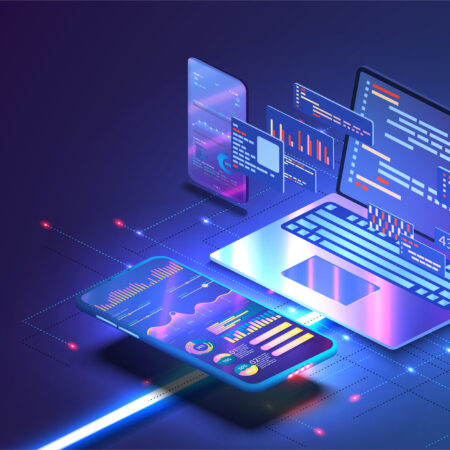In this month’s digi.io column, Sam Horowitz, Head of FX Distribution and Liquidity Management at CMC Connect, delves into the evolution of trading technology and the opportunities and challenges that artificial intelligence presents to the sector.
With a background in electronic markets, Sam has spent nearly 30 years in trading and trading team management. CMC Connect is the institutional division of CMC Markets, offering liquidity solutions and tailored trading technology to banks, brokers, family offices and hedge funds. With an electronic offering that has seen constant evolution since its launch in the 1990s, CMC is one of a handful of firms that can realistically claim to have transacted the first B2C electronic FX trade. As such, CMC is essentially one of the world’s oldest fintechs.
We caught up with Sam to discuss how technology continues to impact trading and the opportunities and challenges that artificial intelligence presents to the sector.
Q. How has technology transformed the trading landscape in recent years?
Technology has been the Darwinian imperative behind almost every major market evolution I have witnessed in my trading career. In its simplest form, it has allowed us to do more with less, but in reality, this is only the tip of the iceberg. Nowadays, trading technology is more than just a workflow tool to allow consolidation and automation of existing legacy techniques. It allows us to trade in ways that simply weren’t envisaged in the original paradigm. High-frequency automated market making, algorithmic execution and bulk data-driven flow classification all build on known historical concepts but take them to places where humans can’t really go on their own.
Q. What specific advancements have had the most significant impact?
I would say there are three broad secular trends that have had a big impact on market dynamics.
Firstly, the ability to bring large datasets to bear on trading problems at speed and scale. It’s easy to say and I doubt this is telling readers anything they didn’t already know, but unless one has traded through the more manual, less data-driven era, where workflows were paper-based and market intelligence was a set of trader heuristics and rules of thumb, it is difficult to comprehend just how seismic a shift we have undergone in the last quarter of a century or so.
Secondly, and this is maybe a very unexciting item to put on the list, but I personally think that standardization of the mechanics of interchange of financial information itself has been one of the biggest impact drivers in trading across almost all asset classes and instrument groups. The ubiquitous nature of FiX as a standard has literally been the glue that has held together nascent electronic markets throughout my time in the industry. Not only has it facilitated efficient and scalable electronic trading between multiple disparate entities and institutions, but it has enabled technology stacks to become unbundled and therefore firms of all sizes can now cut their cloth according to their needs, retaining true IP and/or trading alpha in-house where it exists, and outsourcing or modularizing those parts of the stack that are more commoditized, or at times, where someone has just done it better and removed the need to re-invent that particular wheel.
Finally, the democratization of data and the toolsets for working with it has been the newest broad trend driving growth and evolution in electronic markets. Frankly, the tools now available to any individual, pretty much off the shelf, at little or no cost, would have been the envy of any large investment bank or systematic trader, maybe even as recently as 10-15 years ago. While on the face of it, this might be dismissed as simply a bunch of nice-to-have tools or comfort blankets for sectors of the market that historically haven’t embraced these ways of working, the view from the front is strikingly different. In short, a greater percentage of client trading activity we see at CMC Markets has some alpha inherently presenting in it than ever before. While this may, of course, throw up some new challenges in terms of extracting value from that flow portfolio (as a risk principal), I can only view this dispersion of trading capability further down the (for want of a better phrase) ‘food chain’ as a good thing for the market as a whole. In short, we are all ‘citizen data scientists’ these days. And rightly so.
Q. What role does artificial intelligence play in trading, and how has it changed traditional trading strategies and decision-making processes?
Artificial intelligence (AI) and Machine learning (ML), if used wisely, can be a boon to the trading process. The two main benefits we see are firstly in the ability to model quite complex, multivariate trading and risk management problems, whether those be relating to price construction, client risk profile classification, execution algo configuration or any one of a dozen other categories of market decision. If it can be measured, it can be improved.
And secondly, these data-driven methodologies in general yield one other intangible but very real benefit – they remove bias, inconsistency and emotion from the decision process.
Q. In the context of trading, what are the key challenges and opportunities you identify in the adoption of AI?
Challenges are primarily threefold – firstly, the sheer mechanical and logistical challenges thrown up when one attempts to walk the path of truly full automation of the end-to-end trading lifecycle. With nice, clean datasets and performant modern tooling, many people can look like data science rock stars. But the hard yards are often in the unglamorous work of hooking up the plumbing. Too often, a purportedly automated trading stack is more like a swan – gliding majestically along the surface, but in reality, driven by the frantically paddling legs we can’t always see.
Secondly, the human challenge is in taking that leap of faith and truly giving over to the idea that data-driven decisions are a good thing to be pursued, if not indiscriminately, then at least as an overarching business priority. In short, to learn to “trust the process.”
And finally, there are all sorts of challenges around data and algo governance, the ethics of AI adoption by businesses that are, for example, retail customer facing, and even the very recent challenges thrown up by the abundance of new, publicly available LLMs such as ChatGPT, in terms of establishing authentic ownership of work product.
The opportunities that these new tools and technologies bring to the trading process? We are likely to see some of the most interesting developments in the next 5-15 years, and many of these groundbreaking advancements may not have even been conceived yet. But, for one, I can’t wait to see where this journey leads next!


